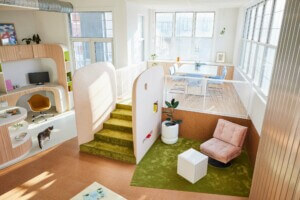In the decade since it was rezoned, Downtown Brooklyn has grown up in a big way. Just look at its skyline and the new apartment towers and hotels that call it home. The open air between those buildings will soon be filled because development isn’t slowing down—it’s just getting started. But the next decade of change in Downtown Brooklyn could offer much more than the first. That’s because as new buildings rose, the area’s street-level never kept pace: public space is still scarce and underused, streets are hard to navigate and dangerous, and educational and cultural institutions have been disconnected. Today, however, Mayor de Blasio announced strategies to change all that by injecting the booming district with new (or refurbished) parks, redesigned streetscapes, new retail, and better connections between its many cultural and educational institutions.
These investments could be transformative in their own right, but are especially notable given Mayor de Blasio’s hesitancy to talk about the importance of urban design. To be clear, New York City’s commitment to safe, livable streets did not die when Mayor Bloomberg walked out the door. In de Blasio’s New York, there have been new bike lanes and the like, but the mayor doesn’t speak about these issues with the force of his predecessor. That seemed to change today as this plan goes all in on urbanism.
“This is one of the city’s great success stories, and we have an incredible opportunity to take these stunning communities, parks, and institutions and knit them together,” Mayor de Blasio said in a statement. “The investments we are making will help Downtown Brooklyn continue its rise, generate good jobs, and make this a more dynamic neighborhood to live and work.”
The plan starts where Downtown Brooklyn starts—at the mouth of the Brooklyn Bridge. The City plans to transform the 21-acre patchwork of underused parks and public plazas between the bridge and Borough Hall into a “great promenade and gateway into Brooklyn.” The renovated space, known as the “Brooklyn Strand,” will be designed to better connect with the area’s transit hubs and the celebrated Brooklyn Bridge Park, designed by Michael Van Valkenburgh Associates. This strategy follows a study commissioned by the Brooklyn Tech Triangle – a cluster of tech companies in Downtown Brooklyn, the Brooklyn Navy Yard, and DUMBO. It was led by WXY.
While not mentioned explicitly, Vision Zero factors into this plan though the City’s strategies to make certain corridors more bike and pedestrian friendly. This includes a multi-million dollar transformation of the Brooklyn side of the Brooklyn Bridge—a plan that was conceived under Bloomberg and is slated to break ground next year. Over on Willoughby Street, the City will “explore non-traditional roadway design that recognizes and accommodates the heavy use of the area by pedestrians.” ARUP is working with the city on that redesign.
The City has also pledged to build a new one-acre public park in Downtown Brooklyn and refurbish two others—Fox Square and BAM Park. The latter has been closed to the public for decades, but will be spruced up by WXY. Fox Square will be renewed by AKRF, with Mathews Nielsen.
To boost business in Downtown Brooklyn, the City will offer-up some of its own ground-floor space to retail tenants. It may also consolidate its 1.4 million square feet to provide affordable office space for businesses. And there are plans to launch a consortium between Downtown Brooklyn’s 11 colleges to “better connect the tech, creative, and academic communities.” This is intended to best prepare students for jobs at Brooklyn’s Tech Triangle. The Economic Development Corporation will provide $200,000 in seed funding to kickstart that initiative.
As part of this plan, the emerging Brooklyn Cultural District, which straddles the blurry border between Downtown Brooklyn and Fort Greene, could get its very own Businesses Improvement District (BID). The City said it will work with the over 60 cultural groups in the district to market the area as a preeminent cultural hub.
Of course, at this point, these are all fairly vague proposals—just ideas on paper unbound by hard deadlines. But this announcement shows that as Downtown Brooklyn builds toward the sky, the City will refocus on the people walking, biking, studying, and working on the streets below.










